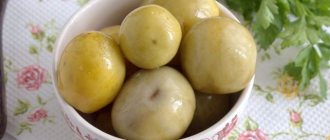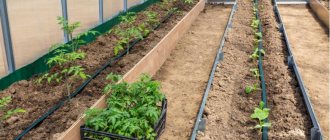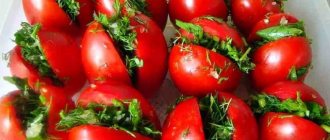There are general rules that should be followed when planning to prepare pickled tomatoes, cucumbers or apples.
First of all, the fruits selected for preservation must be intact, without dents or rot, and sufficiently ripe - after all, lactic acid is formed as a result of the fermentation of sugar. If this condition is not met, the vegetables will not be stored well, and their taste will noticeably suffer.
The second important point is the correct temperature regime: optimal values for fermentation are from +15 to +23 degrees Celsius. If the temperature is lower, the fermentation process will slow down significantly, and if the temperature is higher, the vegetables will spoil.
Finally, before placing them in a container, the fruits must be thoroughly washed and the dishes must be scalded with boiling water to prevent the growth of harmful bacteria that can deteriorate the quality of the products. You can prepare pickled tomatoes in various ways. Traditionally this was done in large oak barrels, but tomatoes cooked in a saucepan or jar are just as good. Beautiful ripe fruits are washed, dried and placed in layers in a container - spices and herbs must first be laid on its bottom. Tomatoes are poured with hot or cooled boiled brine (2 tablespoons with a “hill” of salt per 2 liters of water). Some of the spices are placed on top. The container is covered and left for fermentation. The tomatoes will be ready in 5-7 days. To improve the process and taste, you can add sugar to the brine - at the rate of ½ cup for every 2 kilograms of vegetables. As for spices and herbs, everyone can focus on their own taste. Traditionally, currant and cherry leaves, horseradish root, garlic, bay leaves, dill seeds, and allspice are added to pickled tomatoes. However, many add something of their own to this list - for example, sprigs of basil, tarragon, cloves, hot pepper. The general rule is this: for every kilogram of tomatoes you need to take 50 grams of greens. An interesting recipe – tomatoes fermented without adding water (“dry” method). To prepare them, washed fruits are pricked from the stem side with a fork and placed tightly in a wide container, topped with tarragon, parsley and celery. Each layer is salted and sprinkled with sugar. The pan or barrel is covered with a clean cloth (gauze), on which a circle is placed and pressure is placed on top. After the brine appears, the tomatoes should be taken to a cool place. For 2 kilograms of vegetables you will need 100 grams of sugar and 1 tbsp. l. salt. Pickled green tomatoes are also very tasty. To prepare them, herbs and spices placed at the bottom of the jar are poured with boiling water, then green tomatoes are laid out, pricked in several places with a fork. Place cloves of garlic and slices of hot pepper between them, pour cold brine: 60 grams of salt per three-liter jar of tomatoes (about a liter of water). Cover the top with cherry or horseradish leaves and sprinkle a little dry mustard to prevent mold from appearing. These delicious pickled tomatoes will be ready in one to two weeks. Then they need to be taken out into the cold. Fans of spicy foods can ferment stuffed green tomatoes by putting chopped garlic and hot peppers, as well as celery and parsley inside each of them. Tomatoes can also be fermented together with apples. In general, no matter what recipe you use to prepare your pickled tomatoes, the benefits of this product will be very high, and the pleasure you get from it will be even higher.
Advantages and disadvantages of pickling
The advantage of the fermentation method over other methods of preparing tomatoes for a long time is that a large amount of vitamins is preserved in this way. Lactic acid, which is formed in the process and at the same time is a natural preservative, is beneficial for the body. But consumption of fermented foods should still be in moderation. They should only be used as an appetizer and not as a separate dish.
You need few ingredients to make pickled tomatoes; they are all readily available: in the store or in the garden. The technology itself is also simple. All that remains is to steal some time from your busy schedule and start preparing tomatoes for the winter.
Food preparation
Firm, slightly unripe tomatoes are suitable for pickling. Very green specimens are also suitable for harvesting. The taste of this dish is original and the appearance is pleasant. A variety of oblong tomatoes similar to plums is very popular. They are hard and retain their shape during fermentation.
Fruits must be sorted by size. It is better that the jar contains specimens of the same species. This also applies to the color of vegetables. You should not put both red and green fruits into containers. Ripe ones will ferment much faster than unripe ones.
The tomatoes are thoroughly washed under running water, wiped dry and punctures or small cuts are made in several places to prevent them from “exploding” when pouring hot brine.
It is important that there is no white core inside the tomato. The pulp should be homogeneous.
Brine can be prepared in different ways, but there are some rules: for 2 liters of water you need to take 2 tablespoons. salt with a slide. To improve the taste of the product, sugar is added to the liquid. It is taken at the rate of: half a glass of sand for 2 kg of tomatoes. It is difficult to guess how much brine will be needed for the quantity of tomatoes harvested. Therefore, it is better to make it with a reserve.
What is pickling?
Pickling is one of the common ways of preparing vegetables for the winter, through lactic acid fermentation. As a rule, vegetables are fermented in their own juice (for this they must be cut) and in brine (you can either cut them or leave them whole).
During fermentation, vegetables soften and ferment, resulting in the formation of an increased amount of lactic acid. Fermented products are characterized by a unique sour-salty taste and attractive aroma.
Cold way
A simple and time-consuming method.
- Place selected tomatoes of the same size in jars, add various spices: bay leaf, garlic cloves, dill, allspice. It is also worth adding cherry or oak leaves.
- Prepare a brine from warm water and salt. Pour the contents of the glass container into it.
- Cover the jars with lids and leave for 12 days in a warm place.
- Then add brine to the container and roll up the lids. Send the product to a cool place until winter.
Let's start the sourdough
Place horseradish leaves, onion, bay leaf, currant leaves, garlic, pepper, cherry leaves and peppercorns in the first layer on the bottom of the pan. Gently place a layer of firm, fleshy red tomatoes on top of the spice layer. Then cover the tomatoes again with a layer of spices. Alternate layers like this until the very top of the pan. The taste of pickled tomatoes in a pan for the winter directly depends on the amount of spices, so there should be plenty of them. After the container is completely filled, you need to prepare the brine.
Boil five liters of water in a suitable container. Add half a glass of sugar and the same amount of salt, stir well and let cool to room temperature. Pour the cooled brine into the pan with the tomatoes. Cover the top of the container with clean gauze, on top of which place either a large plate or a lid of a slightly smaller diameter than the pan used for sourdough. Press it down with something heavy and take it out onto the balcony. The gauze must be changed whenever it gets dirty. In about eight to ten days, the red pickled tomatoes in the pan will be ready to eat.
Hot way
- Spices and various additives are first placed in sterilized jars. This could be: horseradish leaves or root, peppercorns, dill and garlic.
- A brine is prepared from water and salt. It boils for 5 minutes and infuses. When hot, it is poured into jars up to the middle of the volume.
- Tomatoes are laid out on top. The final layer is fragrant sprigs of greenery. Then the brine needs to be added to the very neck of the jar.
- The container is turned upside down and left for 3 days. Then put it in a cool place.
After a month you can try the snack. You can also place a plate of pickled tomatoes, prepared with your own hands, on a festive table.
Popular recipes for salted green tomatoes in a “barrel-like” pan
Tomato preservation occurs using several methods. The most common of them are cold pickling and sourdough of tomatoes. Each method has its own characteristics and subtleties of preparation.
Cold salting
This salting method is used in cases where there are not so many raw materials for harvesting. For example, 1-2 kg. A pot of tomatoes can be stored covered on the balcony or in the basement. However, the room must have a positive temperature - from 3 to 10 degrees. It is worth noting that for salting you will have to use enamel containers; other pans will oxidize.
For preservation you will need the following products:
- 4 kg of tomatoes (same size and level of ripeness);
- 6-8 pieces of bay leaf;
- 10 heads of garlic;
- 15 black peppercorns;
- 5-7 dill umbrellas;
- 1 spoon of dry mustard.
Instant cooking
It’s always nice when preparations require a minimum of financial costs and time. In the case of quick cooking of tomatoes, you will need very few ingredients.
- Spices and tomatoes are placed in prepared, sterilized jars.
- You definitely need to put dill umbrellas and garlic on top.
- Pour hot brine over the contents. You can prepare it by diluting and boiling salt and sugar in water.
- Close the containers with lids and let stand for a day in a warm place. After this, take it to the cellar or put it in the refrigerator.
Experienced housewives must pierce each fruit where the stalk grows; this will prevent the vegetables from cracking when boiling liquid is poured into them.
Proven Recipes
Three-day method with celery and dill
Product preparation:
- Three kilograms of medium-sized tomato fruits are washed and wiped dry with napkins. Using a sharp knife or a special device, remove the stalk, cutting out part of the place to which it was attached.
- A bunch of celery is disassembled into stalks, washed thoroughly, and cut into cubes of 9-10 centimeters.
- In this recipe, it is possible to use dill in two versions: the first is greens (1 bunch), the second is seeds (2 tablespoons). If greens are used, they are simply washed without disassembling into branches.
- A head of juicy garlic is disassembled into cloves and each of them is peeled.
Three liters of water are boiled with 6 tablespoons of sugar and the same amount of salt. After active seething begins, celery stalks are lowered into the solution for 30 seconds, no more. To make it easier to remove them from boiling water, they should initially be blanched in a sieve or colander.
After manipulating the celery stalks, reduce the heat under the pan to a minimum, and begin to collect vegetables in a jar. There is no particular difficulty here: the tomatoes are placed in a sterile container mixed with pieces of celery, garlic and dill. It is advisable to place the tomatoes with the punctures facing up so that air can escape from the fruit when pouring.
Fill the jars with hot brine to the very top, cover them with lids without twisting them. After 3 days, a sample is taken, if the taste of the tomatoes suits you, then the jars are closed with nylon lids and stored in the main compartment of the refrigerator.
Tip: Do not pour out part of the remaining brine, but leave it for a day. If the tomatoes in the jars absorb the marinade during this time, add it to the required volume.
According to the instructions from the channel “Recipes from Mom,” you get simply wonderful stuffed tomatoes with herbs and peppers.
With vinegar in 2 days
First of all, prepare the marinade. To do this, boil water (3 liters) in a saucepan with the addition of 3 tablespoons of salt and 1.5 tablespoons of sugar. From the spices add peppercorns (10 pieces) and 3 bay leaves. After the brine boils, pour in 1 cup of 9% acetic acid. Bring the mixture to a boil and turn off the stove. The marinade should cool slightly before pouring.
Tomatoes (4-5 kilograms of medium or small size) are cut from the opposite side of the stalk, approximately to the middle of the fruit. Insert 3-4 leaves of fresh parsley and 2 celery leaves into the resulting slit.
In a clean, preferably sterilized, dry jar, place a bunch of parsley, washed and scalded with boiling water, at the bottom. Next, lay out the stuffed tomatoes. The topmost layer is again parsley.
The filled jar is filled with warm brine. Cover the container with a lid on top, but do not screw it on. Instead of a lid, you can use a flat ceramic saucer.
To ferment the tomatoes, leave them warm for 2 days. The brine should become cloudy and light foam should form on top under the lid. At this time, a sample is taken from the tomatoes; if everything is satisfactory, the jar is closed with a nylon or screw lid and sent for storage in the refrigerator.
You can read about the weekly salting of green tomatoes stuffed with carrots and herbs in our article.
We recommend watching a video from the Distilliruem channel about fermenting red tomatoes in an oak barrel.
Forty-day sourdough with garlic in jars
To fill, boil 2 liters of water with the addition of spices: salt 2 tablespoons and sugar 10 tablespoons of the same volume.
1.5 kilograms of tomatoes, preferably plum-shaped, are washed and dried on a towel or paper napkin. Using a sharp knife, cut off the “butts” along with part of the pulp. It looks as if the cap has been removed from the tomatoes.
Several indentations (from 3 to 4) are made in the cut of the fruit. A clove of garlic is inserted into each cut. To do this, the clove is first cleaned and cut lengthwise into several parts. On average, it takes one clove of the aromatic vegetable to stuff one tomato.
The fruits stuffed with garlic are placed tightly in a jar and poured with the broth, cooled to room temperature. The jar is screwed on with a metal screw or nylon lid. Before use, the lids are doused with boiling water or sterilized along with the jars.
The workpiece is immediately put into a refrigerator or cool cellar. After 10 days, you can treat your household with pickled tomatoes.
A detailed recipe for four weeks of salting green tomatoes in a large bucket is in our article.
Andrey Rostovsky offers a recipe for pickling brown tomatoes in a food container.
Fermented green tomatoes in a saucepan
Zelenets (3 kilograms) are selected with the correct shape, without damage or traces of disease. The fruits are washed and removed from the stalks.
The greens (a large bunch of leaf parsley and celery, 2 horseradish leaves and 20 cherry leaves) are washed under running water, freeing them from sand and dust, and then scalded with boiling water. The hot pepper pod is freed from seeds and also doused with boiling water. Two large heads of garlic are separated into cloves and peeled.
In a wide saucepan on the bottom put 1/3 of parsley leaves, celery, ½ of horseradish leaves, and half of cherry leaves, a pod of hot pepper and a head of garlic, disassembled into slices. Place tomatoes on the greens in one layer. The fruits are covered with another piece of parsley and celery, and another layer of tomatoes is placed on top. The last and final layer is the remains of all the spices.
Now the brine. It is cooked from only two components: water (3 liters) and salt (150 grams). Hot liquid is poured over the tomatoes.
Cover the pan with a lid, leaving a small gap, and put it away in the cold. The tomatoes will ferment fully no earlier than in 2-3 weeks.
The author of the Tasty Dialogue channel, blogger Elena Bazhenova, suggests fermenting unripe tomatoes in an enamel bucket.
In cold water with grape leaves
Pre-treatment of 2 kilograms of tomatoes is reduced only to washing and piercing with a toothpick from the side of the stalk.
The foliage of the grape tree is thoroughly washed in proton water. Then wrap one tomato in each leaf and place them tightly in a pan in several layers.
For brine, use ordinary clean drinking water. There is no need to boil anything! For two liters of cold base, add 4 tablespoons of each type of spice: salt, sugar and dry mustard powder. This mixture is poured over tomatoes. To prevent them from floating up, a pressure is placed on top, which is placed on a flat dish. An ordinary liter jar filled with water can act as a weighting agent.
The tomatoes are fermented for 24 hours in a warm place, at room temperature, and then put away in a cellar or other cool place. Tomatoes are considered completely salted after 2 weeks.
Note: Grape leaves should not be thrown away after fermentation. They can be left for “storage” in brine, and, if necessary, used to prepare homemade dolma.
The author of our site shares the recipe for carbonated tomatoes fermented in a plastic bucket with cloves and mustard in his article.
Stuffed pickled tomatoes
A very beautiful dish and very easy to make. The filling for tomatoes can be made from any vegetables, but carrots and bell peppers are most often used. Add spices and herbs to taste. Here is a very popular recipe.
- The tops of prepared, well-washed tomatoes must be cut off. Carefully scrape out the seeds and all the pulp.
- Peel the bell pepper and cut it into small pieces. Grate the carrots on a fine grater, squeeze the garlic through a press, and chop the greens.
- Mix all ingredients for the filling and add salt. For those who like spicier snacks, you can add hot pepper.
- Stuff the tomatoes with the mixture and cover with the cap that was cut off before.
- Place all vegetables, lids up, in a saucepan. Place a plate on top and put pressure on it.
- Tomatoes need to be filled with brine consisting of water, sugar and salt. Do this so that the liquid completely covers the plate.
- Leave for a couple of days at room temperature, then put in the refrigerator.
You can stuff not only ripe tomatoes, but also green ones. This original appetizer will surprise and delight all guests.
Useful tips
- Only hard fruits should be selected for pickling. The “cream” variety is suitable. Vegetables can be unripe, of absolutely any color: red, orange or green. On the contrary, such a multi-colored assortment will look very impressive on the table.
- If you take overripe, soft vegetables, they will turn into mush and take on a completely unattractive appearance.
- All copies should be sorted by size. In this case, they will ferment evenly.
- When choosing spices for preparation, you can show your imagination: in addition to the usual dill and garlic, add rosemary, celery and mint. They will make the taste and aroma of pickled tomatoes piquant and interesting.
- Each fruit must be pierced in several places with a toothpick or a small incision made.
- The brine in the jars should completely occupy the entire space and cover the tomatoes.
- Horseradish leaves are used to prevent the formation of mold on the product.
- Cherry and currant leaves are used to strengthen the fruit.
- Fans of spicy tomatoes add mustard and red hot pepper when fermenting.
Pickled tomatoes can be stored for no more than 8 months. The best place for this is a cellar or refrigerator.
Site articles on the topic
- When to plant tomatoes for seedlings at home, timing of planting tomato seeds in January 2022, lunar calendar of favorable days for seedlings
- New tomato seeds
- Tomatoes: folk growing tips
- How to properly plant tomatoes in open ground
- Standard tomatoes: main issues of cultivation and care
You may also find the following materials useful:
- Useful properties of ginger and ginger tea recipes
- About the benefits of Russian tea. Originally Russian drink - “IVAN - TEA”
- History of the Russian samovar
- The optimal choice of coffee maker
- Dietary dishes, as well as zucchini pancakes and pancakes
Preparing Ingredients
The first thing you need to do is thoroughly wash the pan with baking soda and pour boiling water over it. The second thing is, of course, to wash very well all the ingredients that are prepared for the pickled tomatoes in the pan. After this you can start fermenting.
Remove the skins from the onion, rinse, divide into two halves and cut into thin half rings. Separate the pepper from the stalk, remove the seeds and cut into large pieces. Cut off the ends of the garlic on both sides and remove the husks. The preparatory part is complete, and you can start putting all the ingredients into the pan.











